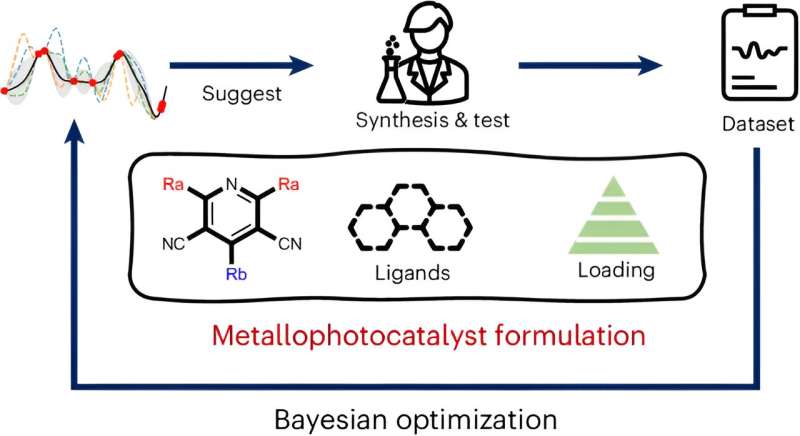This article has been reviewed according to Science X's editorial process and policies. Editors have highlighted the following attributes while ensuring the content's credibility:
fact-checked
peer-reviewed publication
trusted source
proofread
Researchers build an AI assistant for synthetic chemists

Researchers at the University of Liverpool have built an AI-assistant to guide laboratory chemists to find new, cheaper ways to make organic molecules.
In a study published in the journal Nature Chemistry, the team from the Department of Chemistry, in collaboration with researchers at IBM, built software that advises chemists on which experiments that they should run next, based on the results of previous experiments. The paper is titled, "Sequential closed-loop Bayesian optimization as a guide for organic molecular metallophotocatalyst formulation discovery."
To date, this has led to a catalyst formulation for a carbon-carbon bond-forming reaction that avoids the use of the precious metal iridium, which costs around $170 per gram.
The new method uses Bayesian optimization, a computational method that can deal with complex, high-dimensional problems which can process large numbers of interconnected variables and is used in areas such as finance, computer graphics, and robotics.
Bayesian optimization could be used to improve almost any complex physical mixture—for example, to create a better cake recipe—but this strategy becomes inefficient for chemistry research unless some of the known chemistry rules are captured.
Professor Andrew Cooper, from the University of Liverpool's Department of Chemistry and Materials Innovation Factory in Liverpool, said, "All chemists know that acids are neutralized by bases, but unless we include this as a rule, a Bayesian algorithm will suggest experiments that laboriously relearn this point. Likewise, in optimizing a cake mixture, a Bayesian algorithm might start by exploring a recipe that contains 99% flour, something that a human just wouldn't do."
However, baking analogies break down for organic reactions, such as those used to make pharmaceutical drugs, where the underlying rules are more complex than for acid-base chemistry. Indeed, in many cases, the reaction mechanisms are not fully understood. As such, there may be no simple set of rules.
Professor Cooper added, "We approached this by calculating physical properties that might influence the reaction—for example, how well the molecules absorbed light. Using this information, the algorithm can infer that some combinations of chemicals might be more effective than others, based on their functions, rather than making random permutations or following an overly simple rule-set."
While this is not human intelligence, it does make these optimization methods smarter. Also, the chemist does not have to stick solely to the algorithm's suggestions—they can throw in their own experiments, too, based on their insights.
However, according to Professor Cooper, "We think of this tool as an AI assistant, not a robot overlord."
In practice, this software tool led the team to discover highly effective iridium-free catalyst formulations in a sequence of 107 experiments—still a significant number, but a small fraction of the 4500 possible reaction combinations that were available.
This method should be transferable to any chemical reactions where it is possible to compute relevant physical properties, or descriptors, to guide the optimization process.
More information: Xiaobo Li et al, Sequential closed-loop Bayesian optimization as a guide for organic molecular metallophotocatalyst formulation discovery, Nature Chemistry (2024). DOI: 10.1038/s41557-024-01546-5
Journal information: Nature Chemistry
Provided by University of Liverpool




















